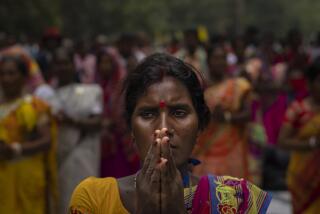India Education Confronts New Challenge as It Adapts to Modern World
NEW DELHI â In a modern New Delhi suburb, students sit in an open-air pavilion around a blazing ceremonial fire and chant age-old rituals.
Heads shaved, dressed in tunics and sarongs, the boys attend a guru kul , a traditional Indian school rooted in thousands of years of Hindu custom and history.
They live as ascetics, sleeping in stark dormitories on straw mats and rising at 4 a.m. for religious instruction, yoga, and meditation. Classes and conversation are in Sanskrit, Indiaâs classical language. Many arrive as 8-year-old boys and donât leave until they are young men.
Yet like so much of traditional India, this venerable form of education is bending to the modern. History studies were introduced this year, and students are pressing for more advanced courses in math and science. In recent years, students have begun watching television. And some are now studying English.
âIn other schools they teach in modern ways, while here we teach in ancient ways,â says Omprakash Arya, a soft-spoken 19-year-old, who has been at the school almost a decade.
âBut we canât progress with just the ancient. The modern is also essential for us to live.â
Strains and Problems
In India, where rapid change is creating new demands, strains, and problems, education is struggling to keep pace.
On one hand, the urban middle class is in a mad scramble for Western education and status. Elite schools have long waiting lists, and many parents sign up their children at birth. Jobs, marriages, and the coveted chance to go abroad are determined oftentimes by where one studies. Huge donations are made and bribes paid to win a child enrollment.
On the other hand, the illiterate millions abandoning the countryside to seek city jobs face the more basic need of learning to read and write.
Three years ago, West-leaning Prime Minister Rajiv Gandhi launched a massive effort to improve and expand primary education in villages, cut the high dropout rate, and boost literacy through informal rural schools.
The government is in a race against spreading illiteracy. Today, more than 60% of Indiaâs 800 million people canât read or write. By the turn of the century, the World Bank predicts, India will surpass China as the worldâs most illiterate nation.
âSkills for the Massesâ
âThe main issues for India are literacy and skills for the masses,â says Krishna Kumar, who heads the education department at Delhi University. âThose are going to be the dominant concerns for some time to come.â
Caught in the crosscurrents, guru kuls are also being penetrated by change. For years, they existed in a time warp, revered in this secular but largely Hindu country as an untouched remnant of an ancient culture.
The guru kul concept dates back almost 3,000 years to the Vedas, the chronicles of early Indian society. At a time when knowledge was passed on by oral tradition, a young boy or girl was sent as a sishya or disciple to the rural school of a guru, propagating the guru kul , or line of the gurus.
The guru kul system began to weaken when the British introduced Western education in the 19th Century to train Indians to run the colonial administration. During the struggle to win independence from Britain, the guru kuls became hotbeds of Indian nationalism.
There are no official figures on the number of guru kuls that are subsidized and run mainly by influential Hindu social and cultural organizations. But observers say they remain popular in the countryside because tuition often is free and their graduates often command clout as pundits and Sanskrit scholars in traditional rural society.
Resurging Fundamentalism
In recent years, they also have enjoyed renewed interest because of resurging Hindu fundamentalism. Underneath the Western patina, observers say, many middle-class Indians value longstanding tradition in the face of change and turmoil sweeping the country.
âRevivalism is finding support in modern, Westernized India,â says Kumar, the New Delhi educator. âThe guru kul has an emotional appeal to most Indians. For many, it hearkens back to an ancient past.â
Given the strains on the school system, the government is trying to nudge the extensive private guru kul network into the modernizing mainstream and offer Western subjects. A prototype is Shantiniketan, a school modeled on the guru ku l and set up by Nobel Prize-winning poet Rabindranath Tagore earlier this century to blend Hindu and Western culture.
At the same time, Indiaâs Constitution requires the government to promote Sanskrit, the basis of Indiaâs 14 major languages. The government currently supports 700 guru kuls and other Sanskrit institutions. It is planning a computerized Sanskrit curriculum and is making videotapes of guru kul studies in Sanskrit to be shown in Western-style schools.
But the old and new donât always mesh. Recently, the government downgraded the importance of Sanskrit in secondary-school exams to promote the learning of more modern Indian languages. Sanskrit teachers, parents, and students have filed lawsuits to force the reinstatement of the language.
âA Binding Forceâ
âSanskrit has been a binding force for millennia in India,â says S.D. Dixit, who heads the governmentâs program in Sanskrit and classical studies. âBut now weâre telling these schools they have to change their programs to keep pace with the modern world. Their students have to be on par with the average man.â
The New Delhi guru kul , founded 55 years ago, was shut down a decade ago for lack of students and an internal management dispute. Now there are 160 students and more than 80 on the waiting list, says the principal, Hari Dev.
Most of the students will go on to teach Sanskrit, although a growing number are turning to more secular pursuits. Om-Prakash Arya says he hoped to become an engineer or a government civil servant and likely will have to take special studies to improve his English after he leaves the guru kul .
More to Read
Sign up for Essential California
The most important California stories and recommendations in your inbox every morning.
You may occasionally receive promotional content from the Los Angeles Times.










